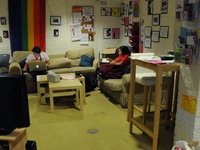With the new lounge space for bisexual, gay, lesbian, transgender, and queer students set to open in the spring, it remains unclear whether the new space will replace or supplement the existing Queer Resource Center in the basement of Thayer Hall, and some student leaders in the gay community find the new space less than ideal.
Dean of the College Evelynn M. Hammonds announced the space—a lounge and two offices in Boylston Hall—last spring, at the same time that she created a new position, director of BGLTQ student life. Hammonds’ decision came in response to the recommendations of the BGLTQ Working Group and to student protests earlier in the year that decried the underground location of the QRC and its lack of a paid staffer.
The new director, Lee Forest, was appointed in September and will start work in November.
According to Emily J. Miller, a student at the Divinity School who is the graduate student intern for the new space, the Boylston offices and lounge will be remodeled over winter break and will open in the spring.
The space consists of two offices formerly occupied by teaching fellows in the Romance Languages and Literatures Department, which will be used by Forest, Miller, and possibly undergraduate interns, as well as an open area where students can congregate and pick up informational material on resources at the College.
The dissatisfaction with the QRC centered in part on the fact that it was located in the basement of Thayer. When the office of BLGTQ student life was allocated space in Boylston Hall, the move was seen as an improvement upon the rather dingy lounge in Thayer. But the new space in Boylston, located one floor below the main entrance, is arguably still in a basement.
“They call it garden level,” said Emma Q. Wang ’12, co-president of Queer Students and Allies. “Whatever you call the QRC—ground level, basement level, garden level—all the same adjectives apply to the floor level of the new space.”
But Wang called the new facilities “a step up,” noting that she’ll be glad to have a space dedicated to BGLTQ student life that is not in close proximity to a trash room.
The room near the garbage bins may not be closing yet, though, and some students would prefer that it does not. Miller and several students involved in BGLTQ activities said that no plans have been made to shutter the QRC.
“This is a lot less bureaucratized,” James R. Sares ’12, a volunteer staffer, said of the QRC, a student-run room lined with shelves full of movies and books pertaining to BGLTQ issues. “There isn’t a paid University person to oversee what’s going on in the space. ... I don’t necessarily think that’s a bad thing.”
Wang also noted that the open structure of the Boylston lounge does not afford the privacy of the QRC.
Moving meetings for the BGLTQ community from the QRC to Boylston would “cut down on the potential to have confidential meetings,” Wang said. She described the Boylston area as “more of an office and a waiting room than a cozy space that is secure for students.”
Wang, who served on the Working Group that asked Hammonds to create a new staffed space, said that the committee was not consulted before Hammonds announced her choice of Boylston for the lounge’s location.
“The devil is in the details,” Wang said. “There are some major drawbacks.”
Despite these concerns, people involved in the creation of the space say they look forward to its spring opening.
“It’s a great gesture to the acceptance of the College,” Wang said. “It genuinely is a big deal.”
—Staff writer Julie M. Zauzmer can be reached at jzauzmer@college.harvard.
Read more in News
Pencils for Kids Founder Inspires PremedsRecommended Articles
-
Dean Condemns Racist GraffitiFour days after police discovered what they described as graffiti that was “biased in nature” in Boylston Hall, Dean of College Evelynn M. Hammonds confirmed that the writing contained racial slurs.
-
Students Call for LGBTQ FundingStudents have voiced concerns that more University resources need to be devoted to LGBT support.
-
Institutionalize Safe SpacesAlthough we are sympathetic to the unfortunate compactness of the current center, finding a larger space could delay the process.
-
 Rediscovering Elocution
Rediscovering Elocution -
The Allied FrontAs a queer freshman, I thought Harvard was paradise. Sure, the Queer Resource Center (QRC) then was in a dim ...
-
Forest Named BGLTQ DirectorHarvard College announced the appointment of its first director of bisexual, gay, lesbian, transgender, and queer student life on Thursday.















